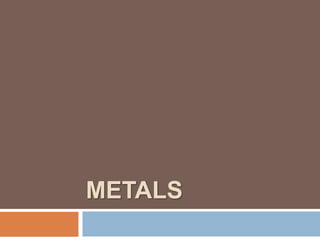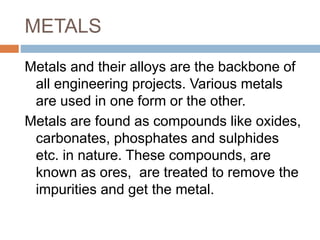METALS.ppt
- 1. METALS
- 2. METALS A metal is an element, compound, or alloy that is a good conductor of both electricity and heat. Metals are usually shiny, malleable and ductile. * Ductility is a solid material's ability to deform under tensile stress; this is often characterized by the material's ability to be stretched into a wire. Malleability, a similar property, is a material's ability to deform under compressive stress; this is often characterized by the material's ability to form a thin sheet by hammering or rolling.
- 3. METALS Metals and their alloys are the backbone of all engineering projects. Various metals are used in one form or the other. Metals are found as compounds like oxides, carbonates, phosphates and sulphides etc. in nature. These compounds, are known as ores, are treated to remove the impurities and get the metal.
- 6. Metals Classification Ferrous metals, wherein iron is the main constituent. We use them in floors doors and windows. Common ferrous metals in use are cast iron, wrought iron and different forms of steel. Non ferrous metals, wherein iron is not the main constituent. Aluminum copper zinc, lead, tin all are classified as non ferrous metals.
- 7. Occurrence Of Iron Iron is never available pure in nature. It has to be extracted in the form of pig iron from various iron ores. Pig iron is the crudest and wrought iron is the purest form of iron. The ores from which iron is extracted are: Magnetite: (Fe3O4). It contains 70 to 75% iron. Haematite: (Fe2O3). It contains 70 % iron. Iron Pyrites: (FeS3). It contains 47% iron but is not preferred because of higher sulphur content which makes it brittle. Siderite: (FeCO3). It contains 40% iron.
- 8. METALS Ferrous metals: The basic component obtained is pig iron. Pig iron is converted into cast or wrought iron. It is very hard and brittle and difficult to bend. It does not rust very strong in compression. I f we re melt pig iron we obtain cast iron. Cast iron is used in rainwater pipes, grating covers. Wrought iron is far different from pig iron and cast iron. It catches rust. It is ductile and malleable that is it can be easily bend.
- 9. METALS Pig iron through various other furnace processes forms steel. Steel When iron is re melted from its ore by commercial processes, it contains more carbon than is desirable. To become steel, it must be melted and reprocessed to reduce the carbon to the correct amount, Steel in itself changes shape. They are used in roofs , slabs, beams, columns,
- 10. METALS Variation of steel. These depend on the carbon content present in them. Mild steel:(0.15%) These are prone to rusting and corrodes easily. This can easily welded. High carbon steel:(0.8-1.5%) High percentage of carbon which makes it more harder , stronger and difficult to weld. It is mostly used for tools and equipments.
- 11. Difference Between Cast Iron and Wrought Iron 1. Wrought iron is more stable, pure and stronger, compared to cast iron. 2. Wrought iron is smelted slowly, whereas cast iron undergoes a faster smelting process. 3. Wrought iron is best outdoors, whereas cast iron is a good indoor decorative element.
- 12. METALS ALLOYS OF STEEL Stainless steel :Incase of ferrous metals if we add chromium to steel we get stainless steel. It is water proof and does not rust. Tungsten steel: When we add tungsten to steel we get tungsten steel which is used in bulbs, magnets.
- 13. METALS Non ferrous metals Aluminum: It is white metal of high metallic luster, obtained from bauxite. Aluminum is a relatively soft, durable, lightweight, ductile and malleable metal with appearance ranging from silvery to dull gray, depending on the surface roughness. It is nonmagnetic and does not easily ignite. Aluminum is the most widely used non-ferrous metal. Used in construction of (windows, doors, siding, building wire, etc.) Transportation (automobiles, aircraft, trucks, railway cars, marine vessels, bicycles, etc.)
- 14. Non-Ferrous Metals-Aluminum Due to its light weight, it is used in the manufacturing of aircrafts and boats. Its other uses are window frames, saucepans, packaging and insulation, pistons and cranks.
- 15. Non-Ferrous Metals-Copper It is another very important pure non ferrous metal. Its red in colour, tough and ductile. It is very good electrical conductor and offers great resistance to corrosion. Copper can work hard or cold but it needs frequent annealing (is a heat treatment that alters a material to increase its ductility and to make it more workable. It involves heating material to above its critical temperature, maintaining a suitable temperature, and then cooling.). Copper is mostly used in the manufacturing of electric wires, cables and conductors. Its other uses are water and central heating pipes and cylinders, Printed circuit boards.
- 16. Non-Ferrous Metals-Brass Another important non ferrous metal is Brass which is not a pure metal but combination of Copper and Zinc. It contains 65% copper and 35% Zinc. This non ferrous metal is very corrosive, yellow in colour, tarnishes (changes in color due to dust or dirt) very easily. It is harder than copper and its good electrical conductor. It is used for decoration for its bright gold-like appearance; for applications where low friction is required such as locks, gears, bearings, doorknobs, casings and valves; for plumbing and electrical applications; and extensively in musical instruments such as horns and bells for its acoustic properties.
- 17. Non-Ferrous Metals-Lead is a pure and an important non ferrous metal. It is the heaviest common metal. - The other characteristics are its softness, malleability and brightness. It is shiny metal when new but quickly oxidizes to a dull grey. It has resistant to corrosion. - Its uses are different than other non ferrous metals. It is used in protection against X-Ray machine, Paints, roof coverings etc.
- 18. Non-Ferrous Metals-Tin is a pure non ferrous metal. It is white in color, soft and corrosion resistant. It is used inTinplate and making bronze. Bronze is an alloy of copper and tin. It is used for the manufacture of household utensils.
- 19. PROTECTION OF METALS FROM NATURAL ENVIRNMENT By the adoption of these processes we can reduce the chances of rusting. TARRING PAINTING GALVANIZING ELECTROPLATING
- 20. PROTECTION OF METALS FROM NATURAL ENVIRNMENT Rusting and corrosion can be avoided by not letting moist air coming in contact with the iron surface. Following methods could be adopted to minimize rusting and corrosion. TARRING Iron is dipped in hot coal tar so that a film of it sticks to the surface which protects the surface from rusting and corrosion. Pipes or ends of poles to be embedded in earth are usually given this protective treatment. PAINTING Paints usually lead paints are applied on the surface to be protected. Exposed metal surfaces as in case of roof trusses and bridge structure are given this treatment which has to be invariably repeated after regular interval of time.
- 21. PROTECTION OF METALS FROM NATURAL ENVIRNMENT GALVANIZING Depositing a fine film of zinc on the iron/steel surface is termed as galvanizing. The surface to be galvanized is first cleared of all the foreign matters by giving it an acid wash to be followed by a wash of clean water. The surface is then dried and dripped in molten zinc. The fine film of zinc that gets deposited protects the surface from contact with atmosphere. ELECTROPLATING By the process of electrolysis a thin film of nickel, chromium, copper or zinc is deposited on the surface to be protected.




















